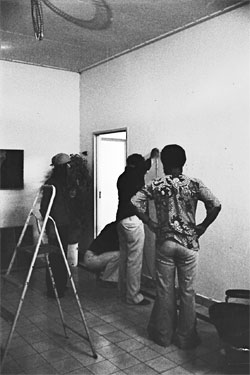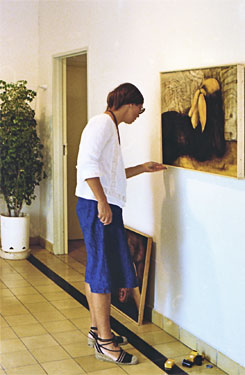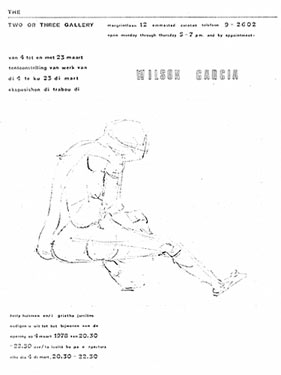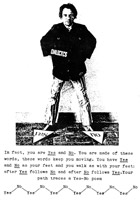
Author: admin
Eksposishon di trabou di Wilson Garcia 4, Maart 1978

Eksposishon di trabou di Wilson Garcia 3, Maart 1978

Eksposishon di trabou di Wilson Garcia 2, Maart 1978
Eksposishon di trabou di Wilson Garcia, Maart 1978

Two or three Gallery
| The two or three gallery | margrietlaan 12 emmastad curacao ned. antillen tel 9-2602 open monday through thursday 5-7 pm and by appointment ta habri for di dialuna te diaweps 17-19 ora open maandag tot en met donderdag 17-19 uur |
| 16 dec. 1975 – 10 juni 1976 |
A Void for the Cabaron press di KORSOW Neth. Ant. |
| 10 juni – 22 juli 1976 |
CeramiC sayings and other forms of abuse |
| 27 sept. – 22 oktober 1976 |
een selectie boeken uit collectie van Other Books and So, |
| 4 januari – 22 januari 1977 |
‘letters to friends‘ – The two or three gallery at |
| 7 maart – 25 maart 1977 |
a selection of THINGS by Martie Genger,Korsow |
| 4 di mart te ku 23 di mart 1978 |
eksposishon di trabou di Wilson Garcia, Korsow |
CeragenetiCs, Amsterdam, 1968-1978
TO WHOM IT MAY CONCERN
hello,
Like you I have only just started. You with your highter studies, and I with a textbook for such a course.
I wrote the first textbook in 1973, or a year earlier perhaps, for the Nova Scotia School of Art and Design Ceramics Department. The book is entitled “AMBIGUITY TOLERANCE”.
It is only logical that I should bestow the title of
“AMBIGUITY TOLERANCE” upon my first textbook in consideration
of the following:
There can be no elaboration upon respective potential of
ceramic materials, techniques and mechanics if one is not:
1) thoroughly aware of the COLLECTIVE CONTENTS referred to
by CERAMICS (and, in particular, the individual departures
therefrom), and
2) willing and able to distinguish between and develop the
subject along with its digression.
TERRIFIC.
I’ve already had to do a bit of crossing out and rewriting, but that’s the way it goes – before I know it I’m going on about things which you haven’t yet come across but which I as an artist encounter on a daily basis.
So, by now I have confessed that this is not the first textbook that I have written, but I have not yet disclosed that the respective title arose directly from the art situation and surroundings of around 1970-’71.
Your invitation to me to guest lecture in the ceramics department for a course in the academic year 1978-’79 presents an enormous dilemna which goes something like this. Before I can say yes or no to your specific question, I must first ask myself a number of questions before my intelligence may prevail over my stubborn resolve to NEVER EVER AGAIN HAVE ANYTHING TO DO WITH CERAMICS BY ANY MANNER OF MEANS.
For the title of the second textbook, “A MONOCHRONOUS
UE IN BLUE”, besides conveying more than one meaning,
is also richly suggestive, and as the preceding pages
show: I have seen more than enough black and blue, on
account of which I refuse to fall into a situation where
I cannot remove the risk of seeing still more black and
blue.
Is this obstinacy on my part?
I don’t think so exactly.
I think it’s rather a case of mistrust.
More so because I don’t understand why I should be at all
welcome in a CERAMICS department of any Dutch academy
what soever.
Furthermore, I share neither the material conditioning of a CERAMICS department nor of cultural conceptions in general nor of an academic structure in particular. Hence the following stamp: aristotle shouldn’t live here anymore. In a Ceramics department of any academy we find, without exception, a potter’s wheel, a jigger wheel, a glaze lab, a spray-gun, a kiln ledger, SEVERAL kilns, an ample ware rack, a room for clay storage and other raw materials, and we have found that in CERAMICS departments for years already, if not centuries, and that is called: MATERIAL CONDITIONING.
Something which I once stamped out for myself as: ROLE OF NO VALUE.
Because this material conditioning makes it difficult to
see that ceramics is also spiritually (in the sense of
the mind or mentally) conditioned or “bound” as well as
“connected” to an archetypal imagery of MAN.
For this reason alone, for the connection with archetypal
imagery related to man, CERAMICS is a constrained art
with its own rules, and rhetoric and I wish to make no
contributions there.
For myself, I have indeed wanted to make acquaintance
with the “archetypal imagery related to man” and place
it clearly and deliberately in front of me, the more so
due to my feelings that I do not share this imagery with
the world around me.
In short, a departure from that imagery.
Therefore, what I must first ask you to do is something
that I did in about 1968, namely, to inter/entomb all
material conditioning under the gravel.
The bonus of gravel is that it precedes clay in the
sedimentary cycle so that one needn’t fear never again
having clay.
The burying of all material conditioning under gravel has
the function therefore of supporting and emphasizing the
question: how necessary is it to objectify something
in clay if one has no knowledge of the COLLECTIVE CONTENTS
which underlie the entire ceramic process.
If ceramographists were aware that material conditioning only leads to the “PARROTING” of “TRADITION” without being conscious of that “TRADITION” in a contextual sense, then the conclusion must be : ONE IS ACTUALLY NOT DEALING WITH CERAMICS as a pure abstraction.
If you could provide me with a gravel base as a podium and professorial chair, that would be nice, but I already carry one around inside me.
What’s really at hand is that it would be a big stap forward if you could get a hold of a gravel-base or otherwise materially deconditioned podium and pupil’s chair. Then we could converse along the lines of “nothing as potentially something” through mail art, for example, at least for the time being, it seems to me. Okay – as far as I’m concerned this scrape – and scrapbook no. 2 antes up for better or worse.
You are receiving this workbook on loan, and it may be photocopied in the necessary quantities, as long as I am kept informed.
The copyright remains ultimately and in principe with me, H ’78.
In addition I expect to have this book returned to me at the end of October along with any reactions from those who wish to go in deeper.
until writing again,
hetty huisman
Martien van Mens
News
NewsLetter comes here
InOutCenter – Tentoonstellingen
Tentoonstellingen:

1973 – 22. october – 3. november :
Geza Perneczky [H] – "Dialectics"

